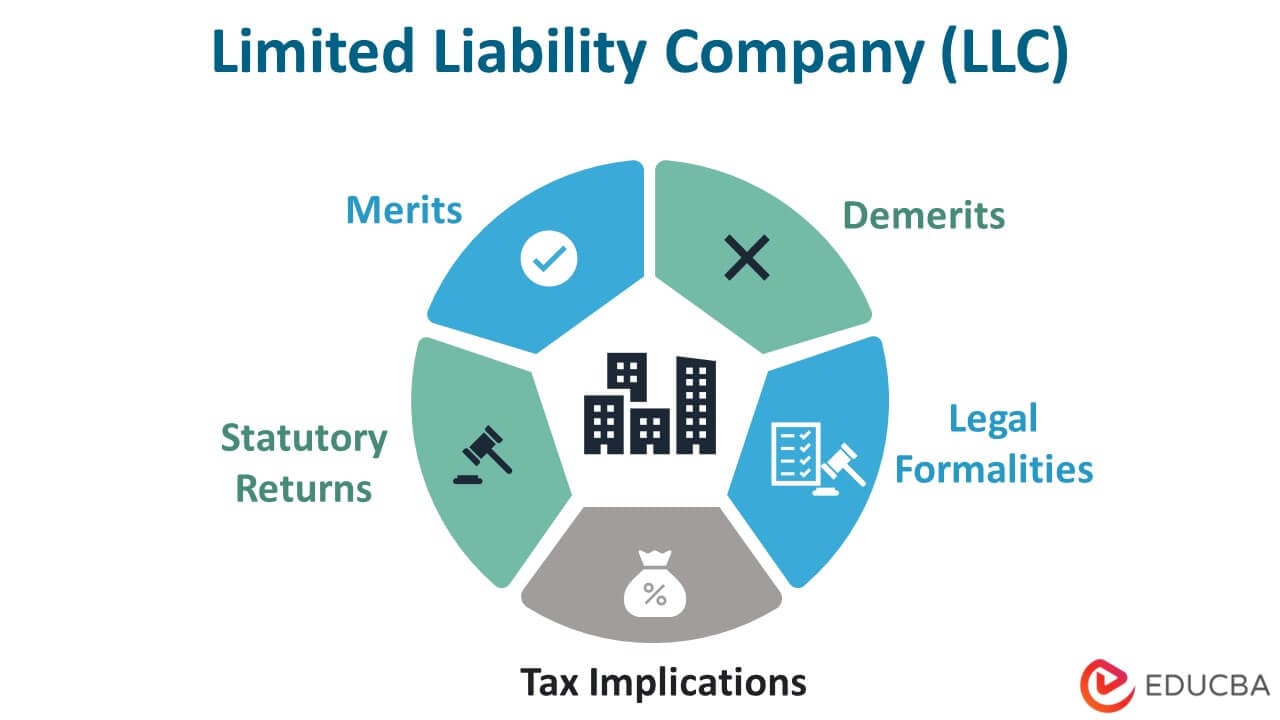Starting a small business requires careful consideration of various factors, including the choice of business entity. One popular option among entrepreneurs is the Limited Liability Company (LLC). An LLC offers numerous advantages, such as liability protection, management flexibility, and tax benefits. This comprehensive guide will delve into the key aspects of LLCs, including their formation process, benefits, disadvantages, and a comparison with other entity types. By the end of this article, you’ll have a solid understanding of LLCs and be well-equipped to make informed decisions for your business.
What is an LLC?

A Limited Liability Company (LLC) is a business structure that provides limited liability protection and pass-through taxation. Unlike sole proprietorships or general partnerships, an LLC legally exists as a separate entity from its owners, shielding them from personal liability for business debts and liabilities. This separation ensures that creditors cannot pursue the personal assets of LLC owners to pay off business debts. Moreover, LLCs offer the flexibility of having individuals, partnerships, trusts, or corporations as members, with no limit on the number of members.
One of the key advantages of an LLC is pass-through taxation. The LLC itself does not pay taxes at the entity level. Instead, the income or loss of the LLC is “passed through” to the owners, who report it on their personal tax returns. This taxation structure eliminates the double taxation that corporations face, where both the corporation and its shareholders are taxed on income.
Benefits of Forming an LLC
Forming an LLC brings numerous benefits that often outweigh any potential disadvantages. Let’s explore the advantages that make LLCs an attractive choice for small business owners:
-
Limited Liability: LLC members enjoy limited liability, which means they are not personally responsible for the business debts and liabilities. This safeguard protects their personal assets from being pursued by creditors.
-
Flexible Membership: LLCs offer flexibility in the composition of their membership. Members can be individuals, partnerships, trusts, or corporations. Unlike S corporations, which have restrictions on shareholders, LLCs have no limitations on the types of members or the number of members.
-
Management Structure: LLCs provide flexibility in choosing their management structure. Members can manage the LLC themselves, overseeing daily operations. Alternatively, they can elect a management group to handle managerial responsibilities. This flexibility allows LLCs to adopt a member-managed or manager-managed structure, similar to corporations but with greater versatility.
-
Pass-through Taxation: LLCs benefit from pass-through taxation, avoiding the double taxation faced by corporations. The LLC itself does not pay taxes at the entity level. Instead, the income or loss is passed through to the owners, who report it on their personal tax returns. This simplifies the tax process and minimizes the overall tax burden.
-
Heightened Credibility: Operating as an LLC can enhance the credibility of a new business. Compared to sole proprietorships or partnerships, an LLC structure signals a more formal and established business entity, which can be advantageous when dealing with clients, suppliers, and investors.
-
Limited Compliance Requirements: LLCs face fewer state-imposed compliance requirements and ongoing formalities compared to sole proprietorships, general partnerships, or corporations. This streamlined administrative burden allows business owners to focus on growing their ventures without excessive paperwork.
Disadvantages of Forming an LLC
While the advantages of forming an LLC are compelling, it’s important to consider the potential disadvantages as well. Here are a few drawbacks that entrepreneurs should keep in mind:
-
Cost: Establishing and maintaining an LLC usually incurs higher costs compared to sole proprietorships or general partnerships. Most states charge an initial formation fee, and ongoing fees such as annual reports or franchise taxes may apply. These expenses should be factored into the overall budget when considering an LLC structure.
-
Transferable Ownership: Transferring ownership in an LLC can be more challenging compared to corporations. LLCs typically require the approval of all members before adding new members or altering ownership percentages. This restriction can complicate the process of bringing in new investors or transferring ownership interests.
-
Additional Compliance Requirements: While LLCs face fewer compliance requirements than certain entity types, they still need to adhere to state-specific regulations. Business owners should ensure they stay updated on any changes or requirements imposed by the state in which the LLC is formed.
Despite these disadvantages, the benefits of an LLC often outweigh the drawbacks, making it a popular choice for small business owners. By carefully weighing the pros and cons, entrepreneurs can determine if an LLC is the right fit for their specific business needs.
How to Form an LLC
Forming an LLC involves several administrative and compliance tasks. While the process is generally easier than forming a corporation, it requires attention to detail. To successfully form an LLC and comply with state laws, follow these eight steps:
Step 1: Choose a State for Formation
When forming an LLC, you have the flexibility to choose any state, even if your business does not operate there. However, most business owners opt to form their LLC in the state where they plan to conduct business. This choice minimizes the need to register as a foreign LLC in another state, reducing formation and administrative costs. State laws, taxation, and costs vary, so it’s crucial to research and select the best state for your LLC’s formation.
Step 2: Select a Name for Your LLC
Choosing a unique name is essential for your LLC’s identity. The name should not already exist on the Secretary of State’s records as the name of another domestic or qualified LLC or business entity. If you operate under a registered “doing business as” (DBA) or trade name as a sole proprietor, you may want to use it as your LLC’s legal name. Before filing your LLC formation, conduct an LLC name search on your formation state’s website to ensure your desired name is available. Consider conducting a trademark search as well to avoid potential intellectual property issues.
Step 3: Appoint a Registered Agent
Every LLC must have a registered agent, also known as an agent for service of process, in the state of formation or qualification. The registered agent receives legal notices, tax documents, and important communications on behalf of the LLC. While the owner can serve as the registered agent, utilizing a registered agent service provider offers advantages, such as ensuring the availability and proper handling of time-sensitive documents. The registered agent must have a physical address in the state, and a PO Box cannot be used.
Step 4: Prepare an LLC Operating Agreement

Although not a legal requirement in all states, having an LLC operating agreement is highly recommended. The operating agreement is an agreement among the members, outlining how the LLC will operate. Even for single-member LLCs, having an operating agreement demonstrates respect for the LLC’s separate existence and helps avoid piercing the corporate veil. A well-drafted operating agreement for multi-member LLCs can prevent disputes among owners, clarify ownership divisions, outline management responsibilities, and address other important provisions. Consulting with an attorney is advisable to ensure all necessary considerations are included.
Step 5: File LLC Formation Documents
To officially establish your LLC, file LLC formation documents, such as a Certificate of Organization, Certificate of Formation, or Articles of Organization, with the Secretary of State’s office or the relevant department handling business filings in your chosen state. The filing fees vary across states. Each state has its own specific requirements, but common elements include the LLC’s name, principal location, purpose, and whether it will be member-managed or manager-managed. Standard forms for these documents are often available on state websites. Once approved and filed, the state will issue a certificate or confirmation, which serves as legal proof of the LLC’s existence.
Step 6: Obtain an Employer Identification Number (EIN)
After establishing your LLC, you must obtain an Employer Identification Number (EIN) from the Internal Revenue Service (IRS). The EIN serves as the identification number used for bank accounts, income tax filings, and employment tax purposes. Additionally, if your LLC conducts business in multiple states, you need to apply for a sales tax identification number in each state and register with the respective state’s labor department.
Step 7: Open a Business Bank Account
While not a legal requirement, opening a separate business bank account is strongly recommended to maintain clear separation between personal and business finances. This separation is crucial in preserving the limited liability protection offered by an LLC. Courts often consider commingling personal and business funds as a factor in piercing the corporate veil. Business bank accounts also facilitate accurate bookkeeping, simplify tax reporting, and establish a clear financial history for your LLC. Contact your bank to understand their specific requirements before opening an account.
Step 8: Register to Do Business in Other States (if necessary)
If your LLC plans to conduct business in states other than the one in which it was formed, you may need to register, also known as foreign qualifying, in each additional state. The criteria for determining whether a company is transacting business in a state can vary, and it’s advisable to seek legal advice from an attorney. Factors such as physical presence, employees, and accepting orders can trigger the need for foreign qualification. Compliance with the requirements of each state is crucial to avoid potential penalties or legal complications.
By following these eight steps, you can successfully navigate the LLC formation process and establish a solid foundation for your business.
Comparing LLCs with Other Entity Types
When deciding on a business structure, it’s essential to evaluate various entity types. Let’s explore how LLCs compare to other popular options:
LLCs versus C Corporations
LLCs and C Corporations have distinct characteristics and advantages. While both offer limited liability protection, LLCs provide greater flexibility in allocating income among members. LLCs can have multiple classes of membership interests, whereas C Corporations generally have only one class of stock. Additionally, C Corporations face double taxation, as the corporation and its shareholders are taxed separately. In contrast, LLCs benefit from pass-through taxation. Carefully consider the specific needs and goals of your business when choosing between an LLC and a C Corporation.
LLCs versus S Corporations
LLCs and S Corporations share the advantage of pass-through taxation. However, S Corporations have more restrictions on shareholders compared to LLCs. S Corporations can have a maximum of 100 shareholders, all of whom must be U.S. citizens or residents. LLCs, on the other hand, can have an unlimited number of members, and there are no citizenship or residency requirements. Additionally, LLCs offer greater flexibility in terms of ownership structure and profit allocation. Consider the limitations and requirements of S Corporations when deciding between an LLC and an S Corporation.
LLCs versus Partnerships and Sole Proprietorships

LLCs, partnerships, and sole proprietorships each have unique characteristics. Sole proprietorships are the simplest business structure but offer no liability protection. Partnerships provide shared ownership but also expose partners to unlimited personal liability. LLCs combine the benefits of limited liability with the flexibility of multiple membership types. When choosing between these options, consider factors such as liability protection, management structure, tax implications, and the ability to attract investors.
Understanding the differences between LLCs and other entity types enables you to select the most suitable structure for your business needs.
Conclusion
Forming an LLC can provide small business owners with valuable benefits, including limited liability protection, flexibility in management and ownership, pass-through taxation, heightened credibility, and reduced compliance requirements. While there are some disadvantages, such as higher costs and ownership transfer restrictions, the advantages of LLCs often make them an optimal choice for entrepreneurs. By following the step-by-step process of forming an LLC, selecting the appropriate state, and understanding the comparison with other entity types, you can establish a solid foundation for your business and position yourself for long-term success.
